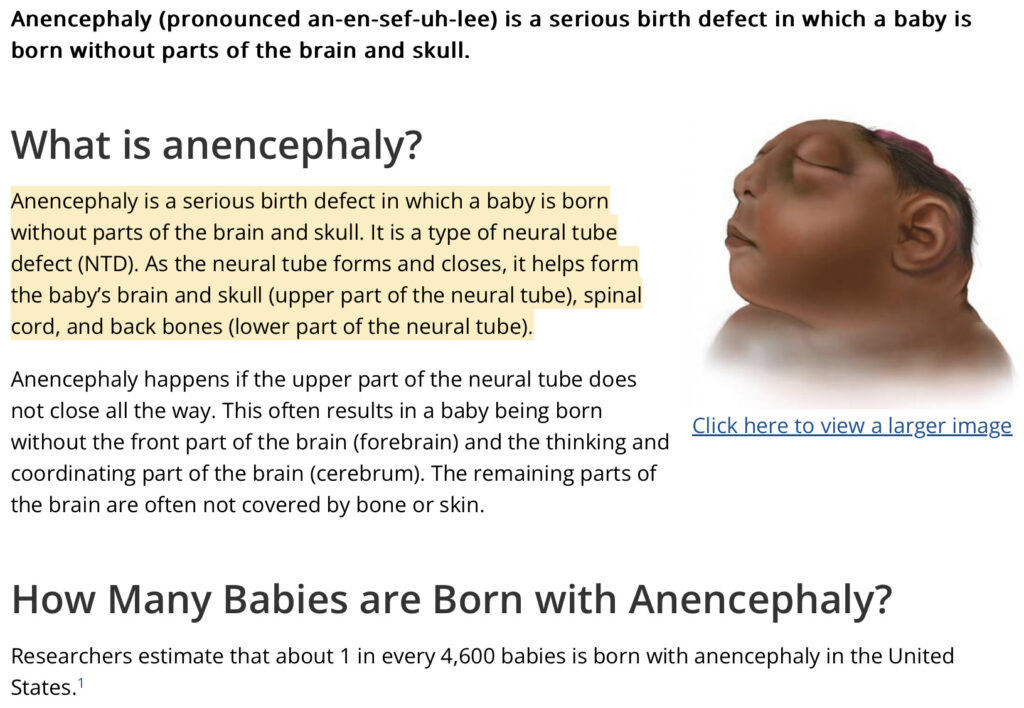
When you make purchases through our links we may earn a small commission.

Photo Credit: Janko Ferlič
Put It On Your Wall: CanvasOnDemand.com
Support thesmokingchair.com through Patreon.
The topic of late-term abortions is a highly sensitive and complex issue that elicits strong emotions and varied opinions. It is crucial, however, to approach this subject with empathy and a commitment to understanding the medical circumstances that may lead to such decisions. Late-term abortions are not sought casually; rather, they often arise from severe medical complications that pose a threat to the health and well-being of both the mother and the unborn child.
Medical Indications

California Abortion Law: Anencephaly (wikipedia.org)
Late-term abortions, typically performed after 24 weeks of gestation, are usually considered when there are severe fetal abnormalities or life-threatening conditions for either the mother or the unborn child. In some cases, serious genetic disorders or developmental anomalies may only become apparent in the later stages of pregnancy, making it a challenging and heart-wrenching decision for parents.
Fetal Abnormalities
In instances where a comprehensive medical evaluation reveals severe fetal abnormalities incompatible with life, parents may face the difficult decision of whether to continue the pregnancy. Conditions such as anencephaly or chromosomal abnormalities may lead to a non-viable or extremely compromised life for the child.
What is anencephaly?

Anencephaly is a severe and often fatal neural tube defect that occurs during fetal development. Neural tube defects are congenital conditions that affect the development of the brain and spinal cord. In the case of anencephaly, the neural tube fails to close properly during early pregnancy, resulting in the absence of a major portion of the brain, skull, and scalp.
In infants with anencephaly, the upper part of the neural tube does not close, leading to the absence of the forebrain (the largest part of the brain), the cerebrum. As a result, babies born with anencephaly typically lack a fully formed skull and brain, and the remaining brain tissue is often exposed. Due to the severity of this condition, infants with anencephaly are usually born with significant neurological abnormalities.
Unfortunately, anencephaly is not compatible with life, and infants born with this condition usually do not survive for an extended period. In many cases, the baby may be stillborn or die shortly after birth. The precise cause of anencephaly is not fully understood, but both genetic and environmental factors are believed to contribute.
What are chromosomal abnormalities that may lead to a non-viable or extremely compromised life for the child?
Chromosomal abnormalities are alterations in the normal structure or number of chromosomes in an individual’s cells. Some of these abnormalities can lead to non-viable pregnancies or result in severe physical and intellectual disabilities in the affected child. Here are a few examples:
Some of these abnormalities include:
Trisomy 21 (Down syndrome): Individuals with Down syndrome have an extra copy of chromosome 21. This condition is associated with intellectual disabilities, characteristic facial features, and an increased risk of certain health issues.
Trisomy 18 (Edwards syndrome): Children with Edwards syndrome have an extra copy of chromosome 18. This condition often results in severe intellectual disabilities and multiple physical abnormalities, leading to a high rate of stillbirth or early death.
Trisomy 13 (Patau syndrome): Patau syndrome involves an extra copy of chromosome 13. It leads to severe intellectual disabilities and physical abnormalities, often causing a short lifespan.
Monosomy X (Turner syndrome): Turner syndrome occurs when females have only one X chromosome instead of the typical two. It can lead to short stature, reproductive difficulties, and various health concerns.
Trisomy X (Triple X syndrome): Females with triple X syndrome have an extra X chromosome. While many individuals with this condition lead normal lives, some may experience developmental and learning disabilities.
XYY syndrome: Males with XYY syndrome have an extra Y chromosome. This condition is often associated with tall stature and may be linked to learning and behavioral difficulties, but the impact can vary.
Cri-du-chat syndrome: Caused by a deletion on the short arm of chromosome 5, cri-du-chat syndrome leads to intellectual disabilities, distinctive facial features, and a cry that sounds like a cat.
Wolf-Hirschhorn syndrome: Resulting from a deletion on the short arm of chromosome 4, this syndrome is characterized by intellectual disabilities, distinctive facial features, and developmental delays.
Klinefelter syndrome: Males with Klinefelter syndrome have an extra X chromosome (XXY). This condition is associated with infertility, reduced testosterone levels, and may lead to developmental and learning difficulties.
Smith-Magenis syndrome: Caused by a deletion on chromosome 17, this syndrome leads to intellectual disabilities, behavioral issues, and distinctive physical features.
These chromosomal abnormalities can vary widely in their impact, and the severity of the condition can be influenced by various factors, including the specific genetic makeup of the individual. Prenatal testing can sometimes detect these abnormalities, allowing for informed decision-making and medical management.
Maternal Health Risks
Late-term abortions may be considered if continuing the pregnancy poses a significant risk to the mother’s health. Conditions such as preeclampsia, severe heart conditions, or complications that emerge later in pregnancy may necessitate a carefully considered decision to protect the well-being of the mother.
Certain medical conditions that arise during pregnancy can pose significant risks to the health and well-being of the mother, and in some cases, they may necessitate carefully considered decisions to protect her. Here are a few examples:
Preeclampsia: Preeclampsia is a serious condition characterized by high blood pressure and damage to organs, often the liver and kidneys. It can develop after the 20th week of pregnancy and, if left untreated, can lead to complications such as seizures (eclampsia), stroke, and organ failure. In severe cases, the only effective treatment may be the delivery of the baby, even if it’s preterm, to protect the mother’s health. Preeclampsia is estimated to occur in 5 to 7 percent of all pregnancies and is one of the leading causes of maternal morbidity. Annually, preeclampsia is responsible for over 70,000 maternal deaths and 500,000 fetal deaths worldwide. In the United States, the rate of preeclampsia in Black women is 60 percent higher than in White women.
- Severe Heart Conditions: Some women may have pre-existing heart conditions that can be exacerbated during pregnancy. Conditions such as severe heart failure or certain congenital heart defects can pose a significant risk to the mother’s health. In such cases, careful monitoring and potentially early delivery may be necessary to manage the risks.

- Placental Complications: Conditions like placenta previa (Placenta previa occurs in about 1 in 200 pregnancies. Pregnancy care providers usually diagnose it in the second trimester during an ultrasound.) or placental abruption (About 1 out of 100 pregnancies has placental abruption. This condition is usually seen in the third trimester, but it can happen any time after 20 weeks of pregnancy up until delivery.) can lead to significant bleeding, endangering both the mother and the baby. Depending on the severity of these complications, the timing and method of delivery may need to be carefully considered.
- Gestational Diabetes: While many women with gestational diabetes can manage the condition through lifestyle changes and insulin if needed, poorly controlled gestational diabetes can lead to complications for both the mother and the baby. In some cases, if the risks become too high, healthcare providers may recommend an early induction or cesarean section.
- Infections: Certain infections during pregnancy, such as severe cases of puerperal sepsis or infections that pose a significant threat to the mother’s health, may necessitate early delivery or other medical interventions.
- Complications with Multiple Pregnancies: Twins, triplets, or higher-order multiples pregnancies inherently carry a higher risk of complications. Issues such as preterm labor, preeclampsia, and intrauterine growth restriction may prompt healthcare providers to carefully consider the timing and method of delivery to ensure the well-being of both the mother and the babies.
In these situations, decisions about the timing and method of delivery are typically made collaboratively between the pregnant individual and their healthcare team. It involves weighing the risks and benefits to both the mother and the baby, with the primary goal of ensuring the best possible outcome for the health of the mother. Open communication between the healthcare team and the patient is crucial in making informed decisions that prioritize the well-being of both.
Ethical Considerations
Navigating the decision for a late-term abortion is a complex process that involves careful consideration of ethical, emotional, and medical factors. It is essential to involve a multidisciplinary team of healthcare professionals, including obstetricians, genetic counselors, and mental health specialists, to support parents in making informed decisions based on the specific circumstances of their case.
Communication and Support
Open and compassionate communication between healthcare providers and parents is crucial throughout this challenging process. Providing emotional support, counseling, and resources to help parents cope with the emotional toll of such decisions is equally important. Ensuring that individuals facing these situations feel heard, respected, and supported can make a significant difference in their overall well-being.
The Last Word
Late-term abortions are not decisions made lightly; rather, they are responses to complex and often heartbreaking medical situations. Understanding the nuanced factors involved, including severe fetal abnormalities and maternal health risks, is essential for fostering empathy and informed discussions surrounding this sensitive topic. It is crucial to approach these situations with compassion, acknowledging the profound emotional and ethical dimensions that accompany such decisions.
You’ll get more articles like this – and our favorite promotional offers delivered straight to your inbox.
By submitting this form you agree to our terms and conditions. You can unsubscribe at any time.

GFYG: Transparent/See-Through | Try On Haul | Lingerie & Dresses



GFYG: MarieMur – Sexy Lingerie Try On Haul!

Unraveling the Circular Reasoning Fallacy: A Logical Loop of Deception

GFYG: SEXY WINTER LINGERIE TRY-ON HAUL


GOP Gets Absolutely STUNNED by Hunter Biden Demand to Testify Publicly





















